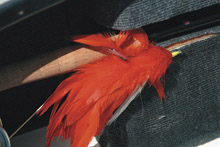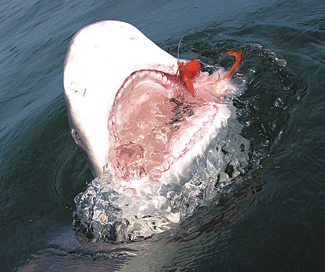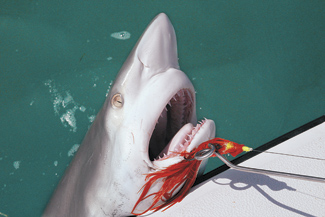May 16, 2011
By Steve Kantner
Go tooth-to-tooth with a shark for a little flyfishing diversion.
By Steve Kantner

Lady angler puts the finishing touches on a respectable Florida Bau shark. |
Sharks are lumbering creatures, driven by urgings as mysterious as the depths they inhabit. We recognize them as rapacious predators, yet as more fly fishermen are discovering, even large individuals will sample an occasional feathery hors d'oeuvre.
Miami angler Marty Arostegui is hardly the typical big-game fly fisherman. Standing a well-muscled five feet from his deck shoes to his hat button, he's often dwarfed by the trophies he conquers. For Arostegui, sharks receive top billing in a cast that includes giant tarpon and billfish. That's why every spring he hops aboard Captain Ralph Delph's 31-foot open fisherman and departs Key West in search of another record catch. So far, he's landed several. His current International Game Fish Association records include a 247-pound lemon shark on 8-pound tippet, a 202-pounder on 12-pound, and his largest to date, the 257-pounder that he recently boated on 16-pound class tippet.
Some background is in order. Specifically, any angler who dreams of landing trophy fish on light tackle is probably already familiar with Capt. Ralph Delph. That goes double for fly fishers, who recognize Delph's expertise in guiding fly rod record-seekers.
A few hours after leaving the dock, Marty and Ralph are set up and ready to go. They're drifting across a flat somewhere between Key West and the Marquesas, where migrating sharks pass on their journey northward. There's a dead, butterflied barracuda hanging from a cleat. With any luck, a big shark will pick up the scent and investigate.
In these waters, the most sought-after species is the tiger shark. These vagabonds of the open ocean attain weights in excess of 1,000 pounds and enjoy a reputation as man-eaters. Back in 1995, Gary Spence landed a 220-pound tiger on 20-pound tippet while fishing off Key West.
Yet while worldwide shark populations are currently at an all-time low, there are enough big sharks left to keep anglers hopping. Arostegui knows about statistics. That is why he attempts to release every shark he lands. So far, that list includes tigers, as well as other “game” sharks. Yet while tigers enjoy local notoriety, Delph has a few observations on the species. “I think they're highly overrated. For example, they do crazy things like swimming towards the boat or popping up on top so I can gaff them easily,” said Delph. I asked him to pick a favorite. “Bull shark, definitely. It's sleek and tough and whenever you hook one, it takes off like a rocket.”
Delph seemed happy to field a few general inquiries. But when I got around to a particular specific, his mood took a decided turn for the worse. “Our season is definitely getting shorter. Lately, it's been shifting more towards February and March, which would correspond with all the jacks and other migratory fish being overfished commercially. The mid-winter shortfall has created a blank spot in the sharks' food chain.”

Delph and Arostegui discuss exit strategy. |
With a single swoop, Delph gaffs the shark in the tail while Arostegui drops his rod and dives for the tail rope. It's a perfect shot, but both men already know the drill. Without pausing, Arostegui snaps the rope around the struggling shark's tail before he and Delph lift it from the water. With its tail out of water, the shark is powerless. At this point, Arostegui grips the rope while Delph hooks the gaff in the corner of the shark's mouth. Together, they hoist the 9-footer into the boat and slide it into a massive, coffin-size livewell that Delph designed expressly to keep sharks alive on their journey to the scales.
Anyway, let's get back to Marty Arostegui. Before long, the first shark of the day appears. It's a lemon, and within seconds it homes in on the chum. As it swims toward the boat, Arostegui assumes the position. He hesitates momentarily, then casts as the shark swims within range. At first, the shark sees the fly but ignores it. Then, on the umpteenth cast, it gulps the orange hackle pattern within spitting distance of the boat.
Water boils and mud flies as the reel spool becomes a blur. Eventually, the shark slows and the battle is on. After an hour, Arostegui is finally able to back up to the stern while Delph reaches for the gaff.
Both men can relax now. Or perhaps reflect on how, during the tail-roping attempt, the shark grabbed a mouthful of fiberglass.

Sharks readily see and eat gaudy, fully dressed flies, and apparently, like a little gel coat for dessert. |
Within minutes, they're heading back to the dock where the shark will be weighed, measured and released. At one point, Arostegui will actually jump in the water and attempt to revive it. No doubt, everyone at the dock is in for a show.
Several years ago, I had my own close encounter of the worst kind.
I was fishing for bonefish in The Bahamas at the time, and can still remember the wind. Visibility was practically nonexistent, which made the going tough. However, on the third morning my guide poled us into a cove where a rim of loblollies provided a modicum of shelter.
I'll never forget it. Everything had a yellowish tint, including the pocked mud bottom which closely resembled that of a redfish warren. The air was redolent with sulfides, but for a change, it carried a note of promise. As proof, when my eyes adjusted I was able to make out the shapes of several lemon sharks, which all looked to be around 100 pounds apiece. I watched as first one, then the others approached.
Everything downshifted into slow motion. I'd watched several minutes earlier as one shark attacked a bonefish. The ferocity was riveting; in fact, the blood was only now beginning to dissipate. By now, I could practically taste the menace. I might add that I'd cast to sharks before, but had only encountered refusals in spite of my repeated attempts.
This time I was ready. I'd seen sharks the day before and decided to bring along a second outfit rigged with a large, double-hooked billfish fly. It was a 10-weight and inadequate by today's standards. But as I was about to discover, it was fare sufficient for the piscatorial ride of my life. A fired-up shark engulfed my fly on the second cast. What happened next was tantamount to witnessing a drag race from the starting line. I'll spare the details by stating that the shark nearly emptied my reel before slowing and eventually letting me lead it to the boat. I was whipped. But not too worn out to jump onto the flat and attempt to unhook the writhing creature which, by now, was firmly impaled on both hooks of the streamer. It was a big mistake. As soon as I removed the fly, the shark turned and made a determined grab for my leg. I was able to push it away the first time. However, a series of repeated attempts convinced me that the only practical recourse lay in a hasty retreat. I made a leap for the casting deck, which put the shark off its mark. I was safe. Still, my departure didn't keep the enraged lemon from turning on the boat and extracting a grinding mouthful of gel coat.
My guide was speechless. But who wouldn't be?
Sharks have an attitude, which reminds me of another trip with guides Andy Novak and Brian Sanders of Fort Lauderdale. We'd headed offshore of Chokoloskee Island in hopes of hooking a really big shark in deep water.
It was my first experience with chumming. As it turned out, Brian managed to hook an estimated 300-pound hammerhead that he fought for several minutes before the hook straightened out. It was a tough break. However, I learned about what it takes to lure big sharks within flycasting range.
The secret—and hardly a revelation—is chumming. Before setting up, we went to the trouble of capturing several large barracudas and butterflying their carcasses. These we roped and hung over the side on a cleat. Chumming is dicey business. Once they're excited, sharks will literally climb aboard in an attempt to get at the chum. Andy had to rip the cuda away to get the shark interested in the fly. It worked. The result deserves a place in fly fishing's all-time adrenaline annals. We all bemoaned the loss of the hammerhead, but I eventually managed to hook and land a nasty little blacktip that bloodied several knuckles and transformed my forearms into a pair of lifeless, protoid blobs. At this point, my conversion was complete.
Large sharks create mega excitement. However, even homicidal monsters begin their lives as cautious, light-tackle adversaries. This encourages guides and anglers to tangle with these first-class predators, especially when other fishing fails. It's always visual and in many instances, sports get repeated “shots.” If there's an all-time shallow-water honeyhole for it, it has to be Florida Bay in Everglades National Park.

This lemon shark is ready for release. Now, how badly do you want your fly back? |
Techniques there vary. However, the most successful remains setting up a chum slick.
Fort Lauderdale's Capt. Doug Lillard fishes out of Flamingo, and was happy to share his knowledge of Everglades sharks. “Most of those I see average between 30 and 150 pounds. They'll show up on any tide, and come into water as shallow as a foot.” I asked how he approached them.
“Let's say we're fishing for redfish and a shark comes along,” said Lillard. “I'll encourage the angler to throw whatever he's got. They'll definitely take a small to medium sized redfish pattern. But when I deliberately target sharks, I'll drift while chumming with ladyfish, which attracts mostly lemon sharks and quite a few blacktips in Park waters. But we see occasional bull sharks and plenty of little stuff like bonnetheads. They'll all bite flies if you get them fired up.”
As far as gear goes, Lillard prefers a 10- or 12-weight outfit with a straight 50-pound mono leader and a heavy wire trace. Does dealing with sharks scare him? “Hooking big sawfish does. Especially when they swing that bill. They've left several deep gashes in my skiff,” Lillard claims.
For readers who may be unfamiliar with sawfish, they resemble a cross between a shark and a ray. Like their name implies, they're equipped with a tooth-lined bill that reaches several feet in length. Will they actually hit a lure? I asked Doug, who began chuckling. “Absolutely. In fact, the little ones get really aggressive.”
Of all game species, few are more deserving of the title than the lesser blacktip or spinner shark. The waters off Palm Beach County are the undisputed capital of Spinnerdom, just as Capt. Scott Hamilton is its unquestioned ambassador, who says spinners on fly tackle are his bread and butter. “During the spinner season, which extends from December to April, I'll run along the beach and look for jumping fish,” he explained. “I find them anywhere from just outside the surfline to a mile or more offshore. Once I locate a concentration, I'll hang a carcass over the side and either anchor up or drift.”
I queried several others who recognize Hamilton's mastery of this burgeoning sport. According to one seasoned salt, they all fish for spinners, but Hamilton's the master. Such endorsements lead to conclusions. No doubt shark fishing's rising popularity has a lot to do with how fly fishermen are discovering that, compared to traditional quarry like tarpon or billfish, sharks can hold their own. “Depending on the time of year,” says Hamilton, “these sharks can average 100 pounds or more. That's a handful on heavy fly tackle.”
I asked what he meant by heavy.
“A 12- or even a 14-weight rod. Keep in mind how tough these fish are. I've fished seasoned tarpon fishermen who had to sit down and catch their breath.”
Hamilton carries several fly patterns for sharks. In addition to the standard orange hackle fly, he uses brightly colored designs, as well as more realistic baitfish imitators for those times when a lot of blue runners or mackerel are around. He fishes straight 50-pound mono with a wire trace unless the customer's after a record. It's not just how hard these fish pull. A major problem results from how the spinners leap and roll up in the leader. Sometimes, if the angler pressures them just right, they'll stay in the water. Then there's a better chance of actually bringing them to the boat.

Captain Scott Hamilton devised this dowel and eyehook to remove flies. |
The releasing part of fly fishing for sharks needs your undivided attention. Hamilton uses a dowel with an eyehook at one end. He slips the hook over the leader and works the fly loose, but whenever a shark is deep-hooked, he cuts it loose.
Glenda Kelley, biologist for the International Game Fish Association, has a yarn of her own to spin. “I was fishing off Key West when a barracuda actually jumped in the boat. We used it for chum. My 95-pound, 12-ounce record blacktip on 16-pound tippet was the result.”
Fly fishing for sharks is the wave of the future. That is, if populations regain their former levels. I've heard persistent rumors that commercial interests are taking hundreds of tons of bulls and spinner sharks from local waters. Surely, no species can sustain such a devastating hit. Conservation is crucial. Whenever possible, anglers should release any shark that they catch.
There's other things for potential shark fly fishermen to consider, among which is the need to get in shape. Keep in mind that fighting big sharks is physically demanding, and that the effect is amplified in hot weather. Marty Arostegui lifts weights and runs. Other experts have serious fitness regimens.
Sharks are wonderful gamefish. They provide hours of unforgettable action, along with a wealth of visual thrills. They're demanding targets that sometimes refuse to strike flies, but for many of us they're still the biggest game in town.
FS
